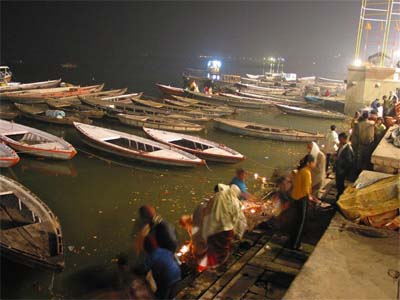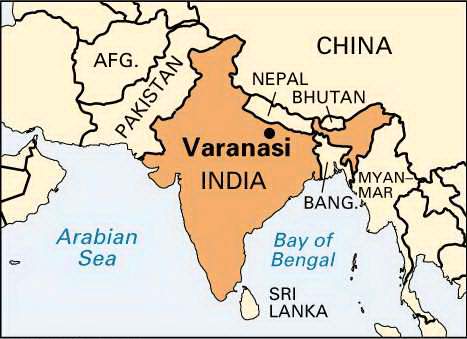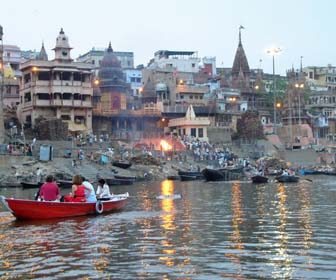By Girish Kumar Dubey
A residential school, in Varanasi city of India's northern Uttar Pradesh state, took the initiative to instruct girl students on methods of learning traditional Hindu scriptures like Vedas and Vedangas (auxiliary disciplines associated with the study of the Hindu traditional scriptures).
More than 80 girls, between the age group of eight to twenty years, reside in the residential education school of 'Panini Kanya Mahavidyalaya'. The girl students are being trained in priesthood, an arena conventionally considered as a male bastion.
Speaking to mediapersons, Nandita Shastri, an instructor said that it was essential to educate the young generation on the need to develop moral principles which will equip them to deal with various hurdles in life.
"No matter how modern we become, at present children are ready to commit suicide over any small issue. They do not have self-belief and they think that in case they fail to achieve their goal, then they have lost everything. So by educating them about their moral values, we tell them that the purpose of their life is very vast and great for which you have to struggle till you achieve 'dharma' (religion), ' karma' (action deeds), 'kaam' (work), 'moksha' (salvation). Your aim should be to achieve 'par brahma' (universal soul). By overcoming the small hurdles in your life, you should move towards achieving your goal and that can be attained by imbibing the moral values," said Shastri.
Meanwhile, the women instructors of the school were also seen performing 'upanayana ceremony' (Hindu thread ceremony) with the girl students. Conventionally, the traditional Hindu thread ritual is performed before the marriage of Hindu men which gives them the authority to perform Yajna (a religious fire ritual) and allows them to read verses and hymns from the traditional scriptures.
Explaining the purpose behind wearing the sacred thread, known as 'Janeu', a student said that the thread represented an oath to always tread on the path of truth during their student life.
"Every human being after wearing this (sacred thread) takes an oath that they would always tread on the path of truth and devote their lives towards studying. We will never use foul language and not indulge in any misdeeds. We would devote our lives to learning the Vedas and would try to become a person who has moral values," Divya Arya, a student.
There are very few schools in India which instruct girls in traditional Hindu hymns and verses in the medium of Sanskrit.
The traditional Hindu scriptures contain hymns and verses written in Sanskrit and has been translated in various other Indian and foreign languages.
EDITORS PLEASE NOTE -RE-SENDING WITH REVISED SCRIPT
A residential school in India's northern Uttar Pradesh state has taken the initiative to instruct girl students on traditional methods of learning Hindu scriptures like Vedas and Vedangas (auxiliary disciplines associated with the study of the Hindu traditional scriptures).
PLEASE NOTE: THIS EDIT CONTAINS CONVERTED 4:3 MATERIAL
VARANASI, UTTAR PRADESH, INDIA (AUGUST 30, 2011) (ANI-NO ACCESS BBC)
1. GIRL STUDENTS IN THE COMPOUND OF A SCHOOL
2. A GROUP OF GIRLS PERFORMING YAJNA (HINDU FIRE RITUAL)
3. THE GIRL STUDENTS CHANTING SANSKRIT SHLOKAS (HYMNS) WHILE PERFORMING YAJNA
4. HANDS OF THE STUDENTS PERFORMING A RITUAL
5. A WOMAN INSTRUCTOR POURING DROPS OF WATER ON THE HANDS OF THE STUDENTS
6. STUDENTS CHANTING HYMNS IN SANSKRIT
7. TWO INSTRUCTORS TEACHING STUDENTS
8. FOLDED HANDS OF A STUDENT
9. FACE OF THE STUDENT
10. AN INSTRUCTOR TYING A ROPE WITH COLOURFUL THREAD AROUND THE WAIST OF A STUDENT
11. INSTRUCTOR TYING ROPE ON ANOTHER STUDENT'S WAIST
12. HANDS OF THE INSTRUCTOR TYING ROPE
13. (SOUNDBITE) (Hindi) NANDITA SHASTRI, AN INSTRUCTOR, SAYING:
"No matter how modern we become, at present children are ready to commit suicide over any small issue. They do not have self-belief and they think that in case they fail to achieve their goal, then they have lost everything. So by educating them about their moral values, we tell them that the purpose of their life is very vast and great for which you have to struggle till you achieve 'dharma' (religion), ' karma' (action deeds), 'kaam' (work), 'moksha' (salvation). Your aim should be to achieve 'par brahma' (universal soul). By overcoming the small hurdles in your life, you should move towards achieving your goal and that can be attained by imbibing the moral values."
14. TWO INSTRUCTORS PRESENTING SAFFRON STOLES TO THE STUDENTS
15. AN INSTRUCTOR GIVING A STOLE TO A STUDENT
16. AN INSTRUCTOR TEACHING THE STUDENTS
17. INSTRUCTOR GIVING STICKS TO THE STUDENTS
18. STUDENTS AND INSTRUCTORS HOLDING A HINDU SACRED THREAD (USED FOR CEREMONIAL PURPOSES) AND CHANTING HYMNS IN SANSKRIT
19. AN INSTRUCTOR CHANTING HYMNS AND PERFORMING RITUAL OF UPANAYANA CEREMONY (HINDU THREAD CEREMONY)
20. ANOTHER INSTRUCTOR PERFORMING THE RITUAL WITH A STUDENT
21. TWO STUDENTS SITTING
22. (SOUNDBITE) (Hindi) DIVYA ARYA, A STUDENT, SAYING:
"Every human being after wearing this (sacred thread) takes an oath that they would always tread on the path of truth and devote their lives towards studying. We will never use foul language and not indulge in any misdeeds. We would devote our lives to learning the Vedas and would try to become a person who has moral values."
23. TWO INSTRUCTORS GIVING FOOD OFFERING TO THE STUDENTS
24. STUDENTS RECEIVING FOOD OFFERING IN THEIR SAFFRON STOLE
 Varanasi, May 23 : A self-help group from Varanasi on Friday sent 543 utensils filled with water of river Ganges to the national capital to raise awareness on river pollution. Ganga, which is revered as holy, also happens to be one of the most polluted rivers in the world. Organisers said that the ''Save the River Ganga'' campaign was to enlist support of the 543 newly elected lawmakers in parliament.
Varanasi, May 23 : A self-help group from Varanasi on Friday sent 543 utensils filled with water of river Ganges to the national capital to raise awareness on river pollution. Ganga, which is revered as holy, also happens to be one of the most polluted rivers in the world. Organisers said that the ''Save the River Ganga'' campaign was to enlist support of the 543 newly elected lawmakers in parliament. Varanasi, May 27 : About 40 Japanese have come together to construct a school for destitute
Varanasi, May 27 : About 40 Japanese have come together to construct a school for destitute Varanasi, Mar 13: Toy industry of Varanasi is losing its sheen as it has been forced to use low quality woods following the ban on 'Koraiyya' wood traditionally used for making toys. The cottage industry has suffered a setback due to the ban on the supply of Korraiya wood as per the forest preservation act.
Varanasi, Mar 13: Toy industry of Varanasi is losing its sheen as it has been forced to use low quality woods following the ban on 'Koraiyya' wood traditionally used for making toys. The cottage industry has suffered a setback due to the ban on the supply of Korraiya wood as per the forest preservation act. Varanasi, Feb 20: A campaign to clean the River Ganges has been restarted with vigour by activists of 146 organisations.The campaigners said they wanted people to join the effort to save the river.
Varanasi, Feb 20: A campaign to clean the River Ganges has been restarted with vigour by activists of 146 organisations.The campaigners said they wanted people to join the effort to save the river. Varanasi, Feb. 20 : To prevent the holy River Ganga from further pollution, a massive campaign has been launched from West Bengal's Gangasagar, the point from where River Ganga flows into Bay of Bengal.
Varanasi, Feb. 20 : To prevent the holy River Ganga from further pollution, a massive campaign has been launched from West Bengal's Gangasagar, the point from where River Ganga flows into Bay of Bengal.